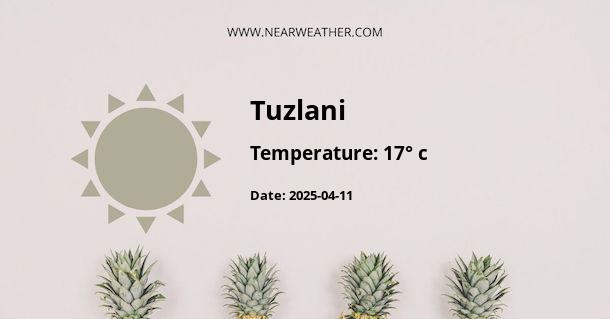Understanding the Climate and Weather of Tuzla, Bosnia and Herzegovina
Tuzla, a charming city located in the northeastern part of Bosnia and Herzegovina, is renowned for its historical salt lakes and vibrant cultural heritage. Climate-wise, Tuzla experiences a blend of continental and moderately oceanic climates, which brings distinct seasonal variations throughout the year. Understanding the weather and climate patterns of Tuzla is crucial for residents, visitors, and business sectors alike.
Geographical Influence on Tuzla's Climate
Geographically, Tuzla is situated in the heart of the Balkans, which significantly influences its climate. The city finds itself in the valley of the Jala River, surrounded by hills and mountains that moderate the climate to some extent. This topography plays a vital role in the distribution of precipitation and the occurence of local weather phenomena.
Temperature Patterns Throughout the Year
In Tuzla, the temperature fluctuates with the changing seasons, showing a clear pattern that can be categorized as follows:
- Winter (December to February): The winter months are typically cold with average temperatures ranging from -2°C to 4°C. Snowfall is common, and the number of daylight hours is limited.
- Spring (March to May): Spring sees a gradual increase in temperature, with averages moving from 5°C to 15°C by the end of May. Precipitation is fairly spread out, providing a mix of rain and the last remnants of winter snow.
- Summer (June to August): Summertime in Tuzla is warm with temperatures averaging between 18°C and 25°C. Prolonged heatwaves can see temperatures soar beyond 30°C, particularly in July and August.
- Autumn (September to November): Autumn observes a drop in temperature, going from mild to cool. Late September and October often witness a pleasant climate before the cooler temperatures set in towards November.
It's essential to note that occasional temperature deviations can occur, influenced by broader climatic conditions such as continental high pressure or the influx of warmer air masses from the Mediterranean.
Precipitation and Weather Events
Annual rainfall in Tuzla is relatively evenly spread throughout the year, although May and June typically see the highest precipitation rates. Here is a statistical breakdown:
| Month | Average Precipitation (mm) |
|---|---|
| January | 32 |
| February | 35 |
| March | 38 |
| April | 48 |
| May | 72 |
| June | 90 |
| July | 81 |
| August | 71 |
| September | 63 |
| October | 53 |
| November | 56 |
| December | 44 |
Aside from rainfall, Tuzla can experience occasional thunderstorms in the summer and foggy conditions in the autumn and spring due to temperature inversions caused by its valley location.
Wind Patterns and Air Quality
Wind patterns in Tuzla generally follow the movement of weather systems across the Balkans. Northeasterly winds can bring cooler, drier air from the interior of the continent, while southwesterly winds can introduce more humid, warmer air from the Adriatic Sea. Because of the industry in and around Tuzla, including coal mining and power plants, air quality can be an important consideration, especially during winter when temperature inversions trap pollutants close to the ground. Local efforts to improve air quality are ongoing, with a focus on reducing industrial emissions and promoting cleaner energy sources.
Seasonal Activities and Considerations
The diverse climate of Tuzla supports a variety of activities throughout the year. The winter snows invite opportunities for skiing and snowboarding in the nearby hills, while the summer months are ideal for hiking, enjoying the Panonian Lakes, and experiencing the city's numerous festivals.
"Tuzla's unique blend of continental and oceanic climate influences not only shapes the local weather patterns but also contributes to its rich natural and cultural offerings." – Local climatology expert
For those planning to visit or conduct business in Tuzla, it is recommended to consider the city's climate and weather patterns. Understanding the seasonal changes and weather events can greatly enhance the experience of staying in this vibrant city. The optimal times for tourism are usually late spring to early autumn when the weather is most favorable.
Climate Change Considerations
As a result of global climate change, Tuzla, like many other cities around the world, has faced challenges with increasingly unpredictable weather patterns. Higher average temperatures, altered precipitation cycles, and the possibility of more extreme weather events necessitate adaptive measures to safeguard the city's population, economy, and natural resources. In response, local authorities and communities are engaging in sustainability initiatives aimed at mitigating the impacts of climate change on Tuzla’s environment and urban infrastructure.
Conclusion
In conclusion, Tuzla’s climate is characterized by a mix of continental and oceanic influences, leading to a weather pattern that offers a full seasonal experience. From the snow-covered winters to the warm, lush summers, Tuzla provides a diverse climate that caters to a wide array of activities and lifestyles. Awareness and preparedness regarding the local weather are imperative for maximizing the enjoyment and potential of this dynamic region. As the world's climate continues to evolve, Tuzla adapts, persisting as a beacon of cultural heritage and natural beauty in Bosnia and Herzegovina.
A - Tuzlani's Latitude is 44.914719 & Longitude is 18.493891.
A - Weather in Tuzlani is 17° today.
A - Climate Conditions in Tuzlani shows few clouds today.
A - Humidity in Tuzlani is 44% today.
A - Wind speed in Tuzlani is 19.4 km/h, flowing at 269° wind direction. today.
